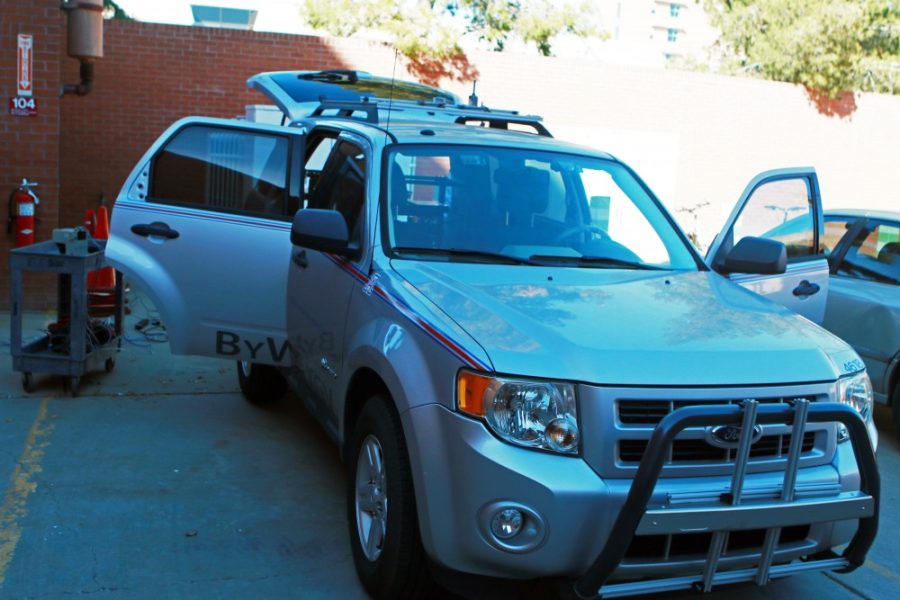UA student engineers want to drive your car for you.
Beginning in February, students from across the country will compete for the opportunity to travel to Tucson and test their winning software on the UA’s Cognitive and Autonomous Test vehicle (CAT).
“The CAT vehicle challenge is aimed at giving people from all over the world the chance to try to program a self-driving car that’s not just a video game,” said Jonathan Sprinkle, UA associate professor in electrical and computer engineering and coordinator of the CAT challenge.

According to Sprinkle, teams of students from around the world will first develop code for a simulator; if the code works well, they will be selected to come to Tucson in the spring and test their software on the actual car.
In the past five years, undergraduate students have had the chance to participate in a 10-week summer program at the university, where they’re given the opportunity to test software on the CAT vehicle just like a graduate student, Sprinkle said.
He explained, “It’s to the point now that the work that they’ve done has enabled much better simulation and better interaction with the vehicle without having to be there in person.”
One of the students’ past accomplishments was designing a programming language that allowed elementary school children to drive the car around a soccer field.
“Basically, we created this very special language for these elementary school kids that guaranteed safe operation of the car, and we could give that to the elementary school students and we knew that whatever they came up with, it would be safe,” said Matthew Bunting, an electrical and computer engineering graduate student.
Safety is a top priority for operators of the CAT vehicle.
RELATED: UA team works on proposed Hyperloop train
Rather than focusing on machine learning, UA is striving to create controllers that can be mathematically proved as safe, Bunting said. This means taking into account all the various conditions the car might come in contact with.
Sprinkle adds that in the lab, engineers strive to build a culture of safe operation by implementing a series of rigorous tests and checks before ever putting the vehicle into action.
“We already know what’s going to happen before we go execute the vehicle, and if that doesn’t happen then we stop execution and we go back to trying to figure out why,” Sprinkle said.
Students also bring a fresh perspective to the innovation process.
According to Sprinkle, two years ago, students developed an Android app that would allow the vehicle to follow the car in front of it using only the phone camera.
He went on to say, “These [successes] show that with a small amount of time you can develop something that’s fairly robust and safe enough to operate without having to have access to big-budget electronics and engineering that we typically see at Google or Uber.”
RELATED: UA student works with team to develop wearable haptic technology
In regards to the future of the self-driving car market, Bunting said we can expect to see more autonomous vehicles on the road in the next few years.
“Technology is definitely happening, but at the same time a lot of this is dependent on machine learning algorithms, and machine learning algorithms are wonderful for solving problems; however they all rely on training data that you provide,” Bunting said.
He explains that a major problem facing autonomous vehicles is the need to collect and process data from every imaginable driving situation.

In the near future, the development of advanced cruise control or self-parking features are more likely, Sprinkle said.
With the future of technology and engineering constantly shifting, it’s important for students to stay up to date on the newest trends. Bunting, who teaches a class that allows undergraduates to interact with the CAT vehicle, said that in 2009 the class was focused on developing apps for emerging smartphones. Now, the focus has shifted to the newest area of development — self-driving cars.
Students aren’t just competing to win an exciting educational experience; they could possibly be developing software for future generations.
“This competition gives you a chance to see why it’s important to stage and plan your approach, so that in the end when you integrate everything together you have great confidence that things are going to work instead of just hoping for the best,” Sprinkle said.
Currently, students from California to Illinois, alongside South America and Asia, have applied to compete in the contest. The competition will end in late April and is sponsored by the National Science Foundation and MathWorks.
Follow Hannah Dahl on Twitter.















